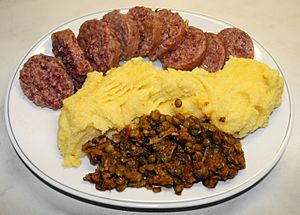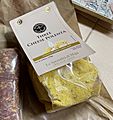Polenta facts for kids
Polenta is a popular dish made from boiled cornmeal. It can be served in different ways. Sometimes it's a hot, creamy porridge, similar to oatmeal. Other times, it's allowed to cool down and become firm, like a loaf of bread. Once it's solid, you can bake it, fry it, or even grill it!
Polenta is a very old food. It's especially popular in Italy, where it's a traditional main food in many parts of northern Italy. You can also find polenta enjoyed in many other countries around the world. These include Savoy, Swiss, Austrian, Croatian, Slovenian, Albanian, Romanian, Bulgarian, and Corsican cuisine. It's also a favorite in Argentine, Brazilian, and Mexican cooking.
Contents
What is Polenta?
Polenta is made from cornmeal, which is simply corn that has been ground into a flour-like powder. Before corn came to Europe, polenta was made from other grains. People used things like farro, chestnut flour, millet, and chickpea flour.
How Polenta is Made
Making polenta is quite simple. You slowly add cornmeal to boiling water or broth. Then, you stir it continuously until it becomes thick and smooth. This can take some time, often 30 to 60 minutes, depending on the type of cornmeal. The slow cooking helps the cornmeal absorb the liquid and develop its creamy texture.
There are different types of cornmeal used for polenta:
- Coarse-ground: This makes a firmer, more textured polenta.
- Medium-ground: This is the most common type, giving a balanced texture.
- Fine-ground: This creates a very smooth and creamy polenta.
Serving Polenta
Polenta is very versatile. When it's hot and soft, it's often served as a side dish. It goes well with stews, meats, and vegetables. Think of it like mashed potatoes or rice.
If you let it cool, it becomes firm enough to slice. These slices can then be:
- Baked: Often with cheese or sauces.
- Fried: Giving it a crispy outside.
- Grilled: Perfect for a smoky flavor.
It can even be used in desserts, especially when made with sweeter ingredients.
History of Polenta
Polenta has a long history. Before the 16th century, corn was not known in Europe. It was brought from the Americas after Christopher Columbus's voyages. Before corn, people in Italy and other parts of Europe made similar dishes using other grains. These early versions were also called "polenta."
Once corn arrived, it quickly became a very important crop. It grew well in many parts of Italy, especially in the northern regions. Cornmeal was cheap and easy to store, making it a staple food for many families. It helped feed many people, especially during times when other foods were scarce.
Polenta Around the World
While polenta is strongly linked to Italy, similar cornmeal dishes are found in many cultures:
- In Romania, a dish called mămăligă is very similar to polenta. It's often served with cheese, sour cream, or stews.
- In the United States, especially in the Southern states, grits are a common breakfast food made from corn. They are very similar to a soft polenta.
- In parts of Africa, cornmeal is used to make dishes like ugali or pap, which are also thick porridges.
These different versions show how a simple idea – boiling ground grain – can become a beloved food in many places.
Images for kids
-
La Polenta by Pietro Longhi, an old painting showing polenta being served.
See also
 In Spanish: Polenta para niños
In Spanish: Polenta para niños




